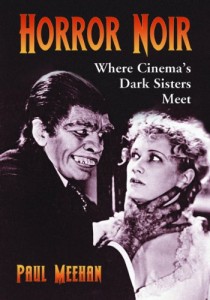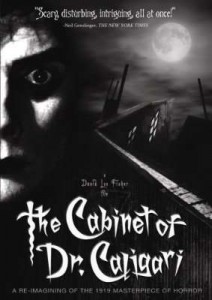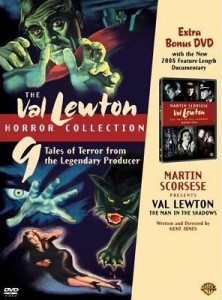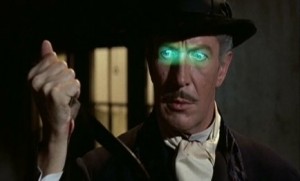 Paul Meehan returns once again to discuss the latest example of his wonderful work in the fantastic. In the past he has visited here to discuss his books Saucer Movies: A UFOlogical History of the Cinema (The Scarecrow Press, 1998), and Cinema of the Psychic Realm (McFarland, 2009), and Tech-Noir: The Fusion of Science Fiction and Film Noir (McFarland, 2008). In this interview Paul discuss his book Horror Noir: Where Cinema’s Dark Sisters Meet (McFarland, 2010).
Paul Meehan returns once again to discuss the latest example of his wonderful work in the fantastic. In the past he has visited here to discuss his books Saucer Movies: A UFOlogical History of the Cinema (The Scarecrow Press, 1998), and Cinema of the Psychic Realm (McFarland, 2009), and Tech-Noir: The Fusion of Science Fiction and Film Noir (McFarland, 2008). In this interview Paul discuss his book Horror Noir: Where Cinema’s Dark Sisters Meet (McFarland, 2010).
TheoFantastique: Paul, thanks for coming back and discussing your latest book. I think you may hold the record for most repeat interviews at this site. This is not the first time you’ve considered noir and its relationship to genres. Given the close relationship between noir and horror as you argue in your book and which can be seen in the book’s subtitle where you refer to them as “cinema’s dark sisters,” why did you decide to address the fusion of science fiction and noir before horror?
Paul Meehan: As a sci-fi/horror fan, I was initially attracted to the study of film noir because of my obsessive fascination with Ridley Scott’s Blade Runner, a film that deftly combined elements of the science fiction and film noir genres. I became haunted by the weird city of night depicted in the film, and in other sci-fi films that followed, and realized that it was an elaboration of the dark city concept that is one of the cornerstones of film noir. Because noir is thought to be a basically realistic genre, in some ways it is closer to the milieu of real-world science and urban science fiction than the otherworldly realms of the supernatural and the monstrous beings that are the stuff of the horror film. But after writing Tech-Noir: The Fusion of Science Fiction and Film Noir, I realized that there was also a degree of overlap between the film noir and horror genres and quickly came up with a list of 100 films that could be incorporated into another book.
TheoFantastique: In what ways do you see horror and noir as so intimately related?
Paul Meehan: What the two genres share most profoundly is their style. Both forms exist within a surrealistic nightmare world of darkness and dread rendered by cinematic techniques such as low-key lighting, unusual angles, moving camera and extreme, distorted closeups. In essence, film noir derived its style from the horror film. Thematically, both genres deal with abnormal psychology, monstrous homicidal individuals, human perversity and the enigmatic workings of destiny. Both have been described as “body genres” that affect the senses directly and activate the “fight or flight” adrenaline response in the viewer as a physiological reaction caused by stress induced by cinematic suspension of disbelief.
TheoFantastique: How did noir and horror come together cinematically?
 Paul Meehan: Both film noir and the horror film trace their origins back to the German expressionist cinema of the silent and early sound period. Beginning with films like The Cabinet of Dr. Caligari and Nosferatu, German film-makers created a cinematic world of fear and shadows that provided the template for both the horror film and film noir. In particular, the films crafted by the great German director Fritz Lang during the early sound period such as M and The Testament of Dr. Mabuse combined the stylistics of the dark fantastic realm of Germanic horror with the world of the crime melodrama for the first time. When Hitler came to power in Germany in the early 1930s, many talented film-makers such as Lang, Karl Freund, Curt and Robert Siodmak, Billy Wilder and Edward G. Ulmer emigrated to America. Some of them, notably Freund in The Mummy and Mad Love, Ulmer in The Black Cat and Curt Siodmak in The Wolf Man successfully transplanted these Teutonic terrors to Hollywood. In the 1940s, the expressionist style was adapted for the mystery/detective story by Billy Wilder in Double Indemnity, Fritz Lang in Scarlet Street and Woman in the Window and Robert Siodmak in Phantom Lady, seminal films noir that served to define the noir genre.
Paul Meehan: Both film noir and the horror film trace their origins back to the German expressionist cinema of the silent and early sound period. Beginning with films like The Cabinet of Dr. Caligari and Nosferatu, German film-makers created a cinematic world of fear and shadows that provided the template for both the horror film and film noir. In particular, the films crafted by the great German director Fritz Lang during the early sound period such as M and The Testament of Dr. Mabuse combined the stylistics of the dark fantastic realm of Germanic horror with the world of the crime melodrama for the first time. When Hitler came to power in Germany in the early 1930s, many talented film-makers such as Lang, Karl Freund, Curt and Robert Siodmak, Billy Wilder and Edward G. Ulmer emigrated to America. Some of them, notably Freund in The Mummy and Mad Love, Ulmer in The Black Cat and Curt Siodmak in The Wolf Man successfully transplanted these Teutonic terrors to Hollywood. In the 1940s, the expressionist style was adapted for the mystery/detective story by Billy Wilder in Double Indemnity, Fritz Lang in Scarlet Street and Woman in the Window and Robert Siodmak in Phantom Lady, seminal films noir that served to define the noir genre.
TheoFantastique: You trace horror noir over the course of several decades of film. Of all the instances of this fusion, which films in which periods do you feel best exemplify the best of this hybrid?
Paul Meehan: A number innovative, horror films set in contemporary America that emphasized crime and abnormal behavior emerged during the 1930s. Among them were the Lon Chaney, Sr. vehicle The Unholy Three, Tod Browning’s Freaks and Michael Curtiz’s Mystery of the Wax Museum. During the 1940s, the films produced by Val Lewton (see below) straddled the boundaries between horror and noir. The 40s also saw the inception of “gothic” and “costume” noirs like Gaslight, The Picture of Dorian Gray, The Spiral Staircase, Bluebeard, The Lodger and Hangover Square, films set in the 19th Century that conjured the mystery and dread of the late Victorian period. In the 1950s, horror noir classics like Charles Laughton’s The Night of the Hunter, Henri-Georges Clouzot’s Diabolique and William Wyler’s The Bad Seed further defined the hybrid horror noir genre, while Michael Powell’s Peeping Tom and Alfred Hitchcock’s Psycho led off the 1960s batch of horror noirs. The ensuing decades witnessed the refinement of this hybrid genre in a series of urban thrillers that included memorable works such as Kolchak: The Night Stalker, Eyes of Laura Mars, Wolfen and The Hunger. One of my personal favorites is the HBO telefilm Cast A Deadly Spell, a comedic treatment that melded the cinematic worlds of H.P. Lovecraft and Raymond Chandler. Private eyes squared off against forces of the supernatural in Angel Heart and Lord of Illusions. The serial killer thriller became popular during the 1990s in the wake of The Silence of the Lambs, leading to further detectives-versus- psychos outings in Se7en, Fallen and The Bone Collector.
TheoFantastique: How significant were Val Lewton and Jacques Tourneur to horror noir?
 Paul Meehan: Producer Val Lewton and director Jacques Tourneur were teamed by RKO studios to crank out low budget B-horror films to compete with the Universal horror product in the early 1940s. But instead of setting their horror films in the long-ago, faraway European milieu of Transylvania or “Visaria” familiar to viewers of Universal movies like Dracula and Frankenstein and their sequels, Lewton and Tourneur decided to set their films in modern urban America, which lent them a fresh immediacy to 1940s-era audiences. The Lewton films, especially Cat People, The Leopard Man and The Seventh Victim emphasized psychological horror rather than supernatural terror. Lewton’s emphasis on abnormal psychology and mystery, along with the contemporary urban setting of these films, moved them closer to the orbit of film noir, which was just emerging as a genre during the early 40s. Many film noir historians credit the Lewton films (along with Citizen Kane) with creating the distinctive “RKO look” that was one of the hallmarks of the noir genre.
Paul Meehan: Producer Val Lewton and director Jacques Tourneur were teamed by RKO studios to crank out low budget B-horror films to compete with the Universal horror product in the early 1940s. But instead of setting their horror films in the long-ago, faraway European milieu of Transylvania or “Visaria” familiar to viewers of Universal movies like Dracula and Frankenstein and their sequels, Lewton and Tourneur decided to set their films in modern urban America, which lent them a fresh immediacy to 1940s-era audiences. The Lewton films, especially Cat People, The Leopard Man and The Seventh Victim emphasized psychological horror rather than supernatural terror. Lewton’s emphasis on abnormal psychology and mystery, along with the contemporary urban setting of these films, moved them closer to the orbit of film noir, which was just emerging as a genre during the early 40s. Many film noir historians credit the Lewton films (along with Citizen Kane) with creating the distinctive “RKO look” that was one of the hallmarks of the noir genre.
TheoFantastique: I was pleased to see you mention Diary of a Madman with Vincent Price as a neglected gem. Can you say a bit about why you feel this is a significant example of horror noir?
Paul Meehan: Inspired by the color and widescreen adaptations of Edgar Allan Poe by director Roger Corman, writer/producer Robert E. Kent adapted two classic stories by Guy De Maupassant into the script for Diary of a Madman. Kent, however, greatly expanded on the de Maupassant stories by adding a number of noir-inspired crime and mystery sub-plots. Vincent price portrays a French magistrate who is tempted into evil by an invisible spirit called the “Horla,” and is further compromised by his relationship with an amoral young woman who leads him further astray in this noiresque tale of insanity, murder, jealousy, betrayal and legal malfeasance. Kent’s screenplay is first rate, as is the direction by veteran horror maven Reginald Le Borg and the performances by Price and the other actors. The screen presence of Price and the art direction of Daniel Haller deftly conjure the look and feel of the Corman Poe adaptations, and IMHO Diary is superior to many of the Corman Poe flicks.
 TheoFantastique: These things obviously move in cycles, but do you envision a continued relationship between these genres?
TheoFantastique: These things obviously move in cycles, but do you envision a continued relationship between these genres?
Paul Meehan: Given the continuing longevity and commercial viability of both horror and film noir, I expect this hybrid genre to permutate into novel and exciting forms in the years ahead. A couple of recent examples would include Chris Carter’s The X-Files: I Want to Believe and Martin Scorsese’s Shutter Island. There will always be a link between horror and noir, the two dark sisters of the cinema.
TheoFantastique: Paul, thank you again for this discussion, and yet another great book on the fantastic.
Related post:
Paul Meehan on Tech-Noir: The Fusion of Science Fiction and Film Noir”





There are no responses yet